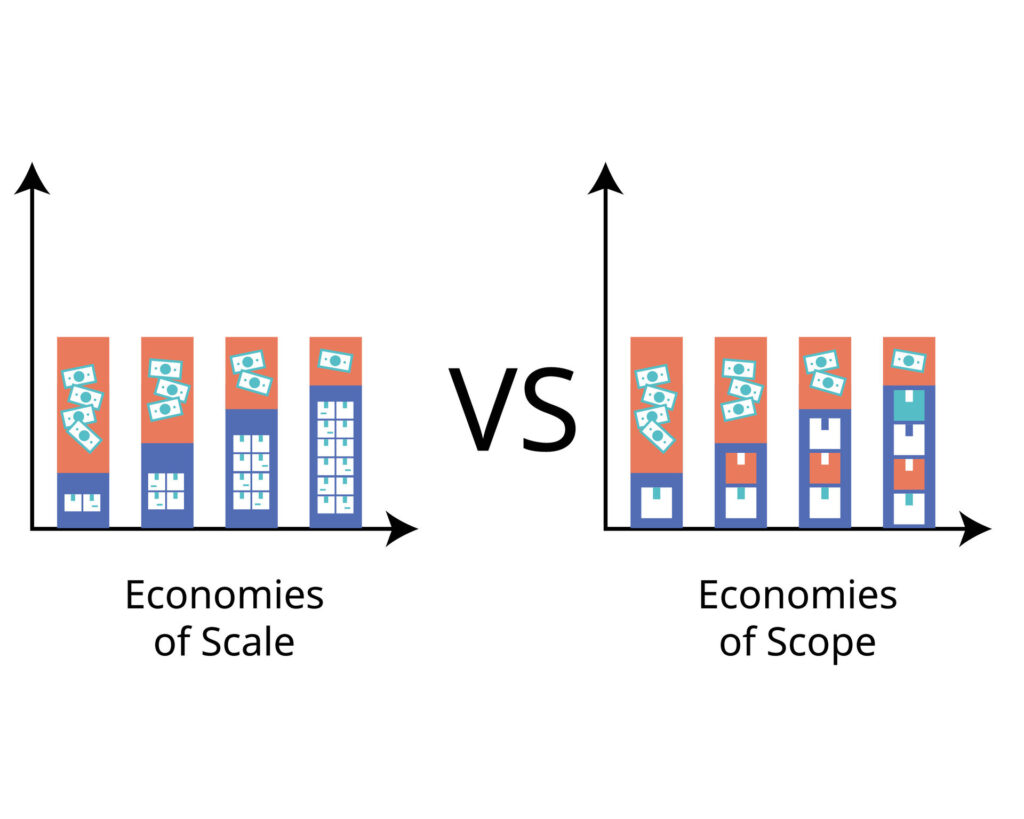How Economies of Scope Drive Competitive Cost Leadership in Ghana’s Dynamic Markets
In today’s highly competitive global market, the pressure on businesses to minimise costs and enhance efficiency is greater than ever. This is particularly true for Ghana, where both large corporations and small-to-medium enterprises (SMEs) are navigating the same dynamic economic landscape. Amid the challenges of rising operational costs, fluctuating demand, and increasing competition, achieving cost leadership, which is the ability to offer goods or services at a lower price than competitors, has become essential for long-term success. Historically, economies of scale have been the go-to strategy for achieving cost leadership. By producing large quantities, businesses benefit from reduced costs per unit, making it easier to maintain competitive pricing. However, while this approach remains valuable, there are other pathways to cost efficiency. In fact, economies of scope offer an equally powerful and often more flexible solution for many businesses, particularly those with diverse product lines or operating in fluctuating markets like Ghana’s. Economies of scope, which involve cost savings through diversification rather than volume, provide businesses with a complementary and sometimes more effective way to achieve sustainable cost leadership. This concept holds significant potential for businesses in Ghana, where diversification is becoming a strategic necessity in response to shifting market conditions and evolving consumer demands. Ghana’s economy and her diverse sectors, from agriculture to technology, present an ideal context for economies of scope to thrive. Local businesses, especially SMEs, are increasingly recognising the need to diversify their offerings to remain competitive. As globalisation continues to influence local markets and consumers demand more variety, economies of scope provide a strategic advantage. UNDERSTANDING ECONOMIES OF SCALE VS ECONOMIES OF SCOPE In business, two powerful concepts often arise in conversations about cost efficiency and growth strategies: economies of scale and economies of scope. While both offer pathways to cost reduction, they differ in their approach and impact, especially in the context of Ghana’s emerging industries. Economies of Scale Economies of scale have long been the cornerstone of cost leadership strategies. The principle is simple: the more of a product a company produces, the lower the cost per unit. This reduction in unit cost occurs because fixed costs such as machinery, factory space, and administrative overheads are spread over a larger number of goods, driving down the average cost. For instance, if a Ghanaian textile manufacturer focuses on producing one type of fabric at high volumes, it can lower its cost per yard by purchasing raw materials in bulk, streamlining its production processes, and maximising the use of its equipment. The result is a lower price per unit, which allows the company to compete on price and potentially dominate the market. However, economies of scale often come with limitations. Businesses reliant solely on this strategy may struggle to adapt to changing market demands, or they might find themselves vulnerable during downturns when consumer demand for a single product declines. In Ghana, where economic conditions can fluctuate and consumer preferences evolve rapidly, companies that focus only on scaling up the production of a single item may miss opportunities for diversification, flexibility, and resilience. Economies of Scope Economies of scope offer a different, and often more versatile, approach to achieving cost leadership. Rather than focusing on producing a large quantity of a single product, businesses can reduce costs by diversifying their product offerings. This strategy allows companies to leverage shared resources such as machinery, labour, marketing channels, or distribution networks across multiple product lines. For example, a Ghanaian agro-processing company might expand its operations beyond producing just shea butter to also offer related products like soaps, lotions, or even shea-based food products. By doing so, the company can use the same equipment, staff, and marketing efforts for all these products, effectively spreading its fixed costs across a broader range of offerings. This leads to lower average costs while simultaneously opening up new revenue streams. Unlike economies of scale, which focus on increasing volume, economies of scope focus on increasing variety. This allows businesses to be more adaptable to market changes and customer preferences. For Ghanaian companies, especially SMEs, economies of scope present an opportunity to not only reduce costs but also hedge against risks associated with relying on a single product line. Core Differences The key distinction between these two strategies lies in their approach to cost efficiency. While economies of scale concentrate on achieving lower costs through higher volumes, economies of scope achieve cost savings through diversification and shared resources. Economies of scale are about doing more of the same thing, whereas economies of scope are about doing different things more efficiently together. In Ghana’s business landscape, where industries such as agriculture, technology, and manufacturing are growing, businesses are increasingly recognising the value of economies of scope. By diversifying product lines and spreading resources efficiently, companies can achieve sustainable growth and reduce the risks associated with market fluctuations. In contrast, while still relevant, economies of scale may limit flexibility and innovation. HOW ECONOMIES OF SCOPE PROVIDE A COST LEADERSHIP ADVANTAGE In a competitive market, businesses are constantly seeking ways to lower costs and gain a strategic edge. Economies of scope offer an alternative pathway to cost leadership. Instead of relying solely on increasing production volume, economies of scope focus on producing a diverse range of products using shared resources, which can dramatically reduce overall costs. In Ghana, where market fluctuations and consumer preferences continuously evolve, this approach is particularly valuable for businesses looking to maintain flexibility and profitability. Shared Resources One key benefit of economies of scope is the ability to share resources across multiple product lines. This includes sharing machinery, labour, and even distribution networks. By doing this, businesses can avoid duplicating expenses for each product they produce, thereby significantly lowering their operational costs. Take, for instance, a Ghanaian company involved in agro-processing. If this company initially produces only palm oil, it may face certain fixed costs, such as purchasing and maintaining processing equipment, paying labour, and covering facility expenses. However, by diversifying into producing additional related products, like palm kernel oil or soap, the
How Economies of Scope Drive Competitive Cost Leadership in Ghana’s Dynamic Markets Read More »




